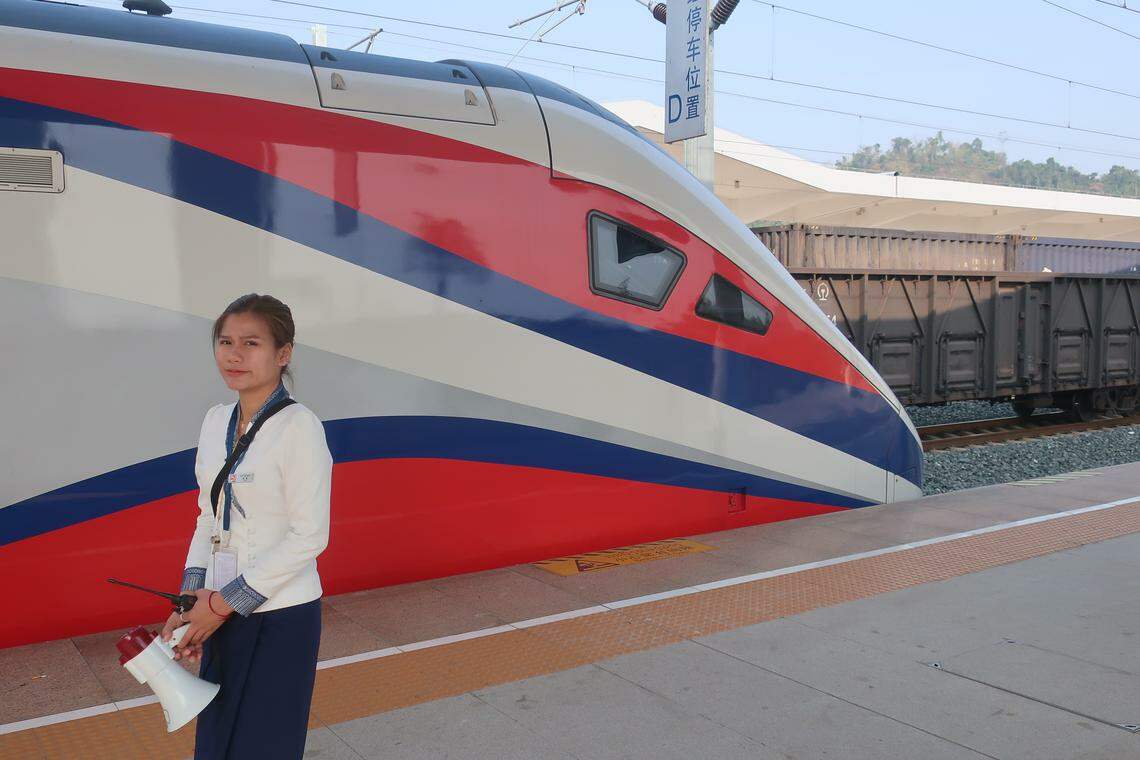Laos-China Railway a boon for recovering tourism sector

[LUANG PRABANG, LAOS] The Laos-China Railway has been operational for a little over two years now, and this US$6 billion project – built with the intention of reducing cargo transit times and transportation costs – has since become a major tourist attraction in itself.
The 420-km link connects the northern town of Boten on the border with Yunnan, China, all the way to the Lao capital Vientiane.
“According to the data we have, the service has been very successful. There has been an increase in the number of trains going north and south, and they are absolutely full,” said Alexander Kremer, the country manager of the World Bank’s office in Laos.
In January this year, the Laos-China Railway added another daily round-trip journey, taking the total to six, to accommodate the surge in demand.
In 2023, the railway carried over 3.1 million passengers with an average ridership of 4,889 passengers per day, according to the state-run Vientiane Times.
These numbers are set to soar throughout 2024, with the Lao government designating it as “Visit Laos Year”.
A NEWSLETTER FOR YOU

Asean Business
Business insights centering on South-east Asia's fast-growing economies.
Laos is the current chair of the Association of Southeast Asian Nations (Asean) bloc, which will see the landlocked country host dozens of high-level meetings and a leaders’ summit – which all spell good news for the country’s tourism and hospitality industry.
The Lao Ministry of Information, Culture and Tourism has targeted 6.2 million trips by Lao and foreign tourists in 2024, spending more than US$1.3 billion on tours, accommodation, food and shopping.
Last year, Laos attracted 3.4 million international tourists, up 164 per cent from the 1.29 million in 2022, according to government data.
And in the current post-Covid recovery period, the train has proven to be a “must-visit” for many visitors, both local and foreign.
“It has become fashionable,” said a Lao economist who preferred to remain anonymous. “Last year, Laos had 1.2 million visitors from Thailand and most of them wanted to be on this train.”
Thailand has some way to go before completing its own high-speed railway. There is work ongoing to upgrade its existing meter-gauge single-track service from Vientiane to Nong Khai – a city in north-east Thailand – into a dual-track system. The expected completion date is 2027.
Medium-speed service
China Railway Group – Laos’ partner in the Laos-China Railway project – started construction of the single-track, standard gauge “medium speed” train in Dec 2016, and completed the project in the prescribed five-year period, despite the Covid-19 pandemic.
These trains can reach a maximum speed of 160 kmh for passenger services, and 120 kmh when carrying only cargo.
“Only China could do that in five years, with 60 per cent of the railroad going through tunnels and over bridges,” said the same Lao economist.

The project has drawn widespread criticism, however, for adding to Laos’ public debt, which currently stands at about 125 per cent of gross domestic product, the highest in South-east Asia. Some observers have warned that this could possibly cause Laos to enter into a so-called “debt trap” with China.
Laos’ debt to China for the project, in which it holds a 30 per cent share, is close to US$720 million.
The lion’s share of the country’s commercial debt – 50 per cent owed to Chinese banks – is for loans taken out to partly finance some 80 hydro-electric dams, as part of the Lao government’s “Battery of South-east Asia” policy.
While economists still question whether the Laos-China Railway will ever make a reasonable return on the massive investment, the knock-on effects for the tourism sector are obvious.
“The train has allowed tourism to expand beyond the main cities in Laos, increasing the access to hard-to-reach towns such as Vang Vieng and Oudomxay,” said Andrea Vinsonneau, the general manager of EXO Travel Laos, a tour agency headquartered in Luang Prabang, Laos’ main tourist city.
“Instead of having to endure a six-seven hour drive by bus or car, you can now get to Vang Vieng in an hour and Luang Prabang in two hours by train,” she said.
“Not only is the train a big time-saver but it’s also cheaper and has a much lower carbon footprint. Since we started using the train for our clients, we have considerably increased their length of stay in Laos,” said Vinsonneau, whose tour agency targets mainly Western tourists.
KEYWORDS IN THIS ARTICLE
BT is now on Telegram!
For daily updates on weekdays and specially selected content for the weekend. Subscribe to t.me/BizTimes
Asean
Malaysian fast food operator QSR shelves IPO plans amid boycott campaign: sources
Microsoft to invest US$1.7 billion in cloud, AI in Indonesia: CEO
Thai economic growth slows in March due to soft demand, tourism
Bangkok airports set for US$4.8 billion expansion as tourism booms
Indonesia’s Mount Ruang erupts again, closes international airport
Singapore, Indonesia to deepen cooperation on green economy

